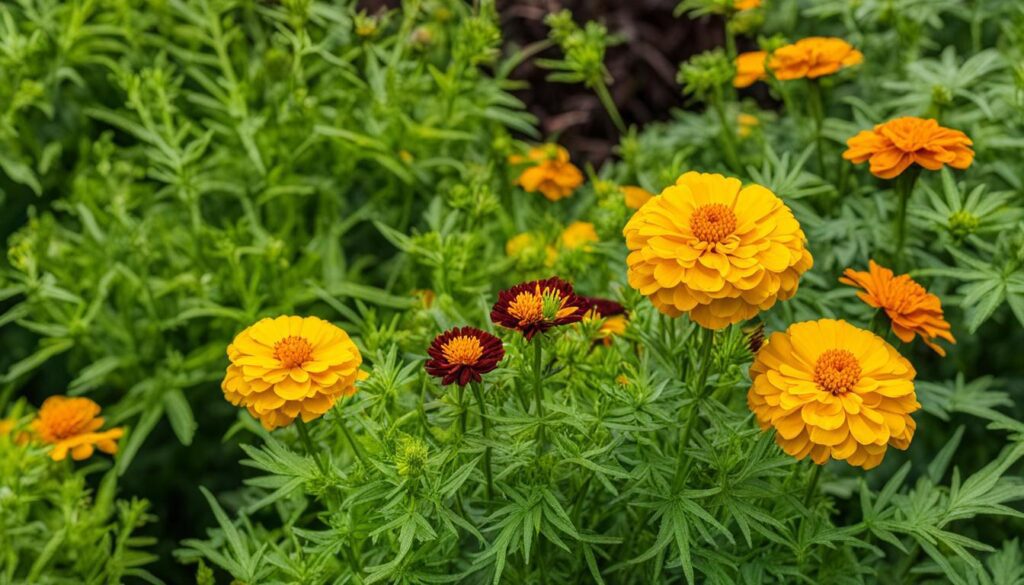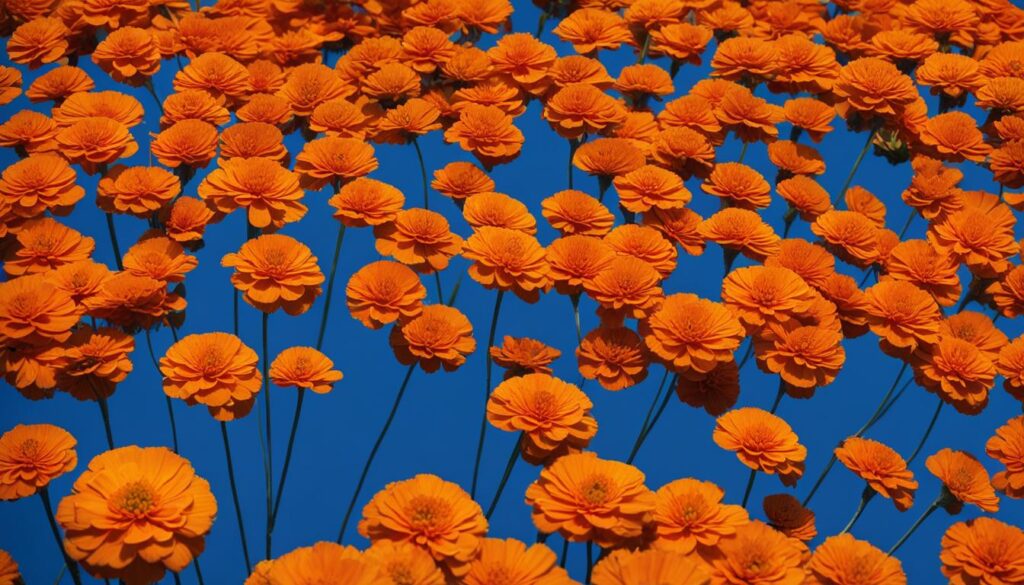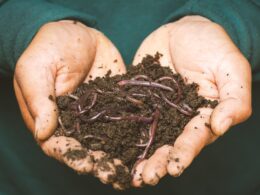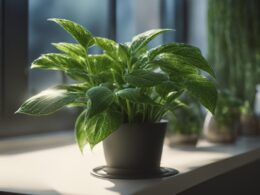Marigolds are often associated with gardens and landscaping, but are they actually considered weeds? Let’s delve into the information from various sources to uncover the truth about marigolds.
Key Takeaways:
- Marigolds are not considered weeds, but valuable flowers with numerous benefits.
- They play a significant role in companion planting, protecting other plants from pests and diseases.
- Marigolds have a rich history, being considered sacred and possessing healing and magical powers.
- There are various species and cultivars of marigolds available, offering a wide range of colors and sizes.
- While there are plants that may be mistaken for marigolds, they do not possess the same beneficial properties.
The Role of Marigolds in Companion Planting
Companion planting is a popular gardening technique that involves growing certain plants together to benefit each other. When it comes to marigolds, their role in companion planting is truly remarkable. Gardeners have long recognized the ability of marigolds to protect a wide range of plants from pests and harmful weeds.
By planting marigolds next to other vegetables and flowers, you can provide natural deterrence against bugs and fungal diseases. The strong scent of marigolds acts as a repellent to many insects, such as aphids and nematodes, effectively keeping them away from your precious crops. Additionally, marigolds release compounds into the soil that help suppress weed growth, reducing competition for nutrients and resources.
Furthermore, marigolds attract beneficial insects like ladybugs and lacewings, which are natural predators of garden pests. These beneficial insects help to keep the pest population in check, creating a more balanced and harmonious ecosystem in your garden.
“Marigolds are like the unsung heroes of the garden. They not only add a splash of vibrant color but also play a vital role in protecting and enhancing the overall health of your plants.”
Maximizing the Benefits
To make the most of marigolds in companion planting, it’s essential to choose the right variety and planting location. French marigolds and African marigolds are commonly used for this purpose. French marigolds, with their compact size, work well as border plants, while African marigolds make excellent choices for larger beds and containers.
When planning your garden, consider interspersing marigolds among your vegetables or planting them in rows between crop plants. This arrangement maximizes their protective benefits and creates an aesthetically pleasing display. Additionally, be sure to select marigolds that complement the color scheme of your garden, as their bright blooms can add a vibrant touch to any landscape.
Overall, incorporating marigolds into your companion planting strategy is a wise choice. Not only do they provide natural pest control and weed suppression, but they also enhance the beauty of your garden. Discover the power of marigolds and create a thriving and harmonious garden ecosystem.
The History and Importance of Marigolds
Marigolds have a fascinating history that spans back to the Aztec civilization, where they were held in high regard and considered sacred. These vibrant flowers were believed to possess magical and healing powers, and were often used for medicinal purposes. The Aztecs used marigolds as antiseptics and anti-inflammatory agents, taking advantage of their natural properties to promote healing and well-being.
Throughout the years, marigolds have continued to play a significant role in various cultures and traditions. They have been used as food coloring and even as a base for natural dyes due to their vibrant colors. In some cultures, marigolds are used to decorate graves during celebrations and rituals, symbolizing remembrance and honoring the deceased. Their presence in these traditions highlights the cultural importance and symbolism attached to marigolds.
Marigolds are not only significant in history and culture but also hold great importance in modern-day applications. With their insecticidal properties, marigolds have become a valuable tool in pest management in gardens and agriculture. They act as natural repellents, protecting other plants from harmful bugs and fungal diseases. This natural ability to ward off pests makes marigolds a popular choice among gardeners who want to promote healthier growth and reduce the need for chemical insecticides. Additionally, the ornamental value of marigolds enhances the aesthetic appeal of gardens, adding beauty and vibrancy to outdoor spaces.
The Healing Powers of Marigolds
Marigolds are not just beautiful flowers; they also possess healing properties that have been recognized for centuries. These flowers contain compounds that have anti-inflammatory and antiseptic qualities, making them useful in promoting wound healing and reducing inflammation. They have been traditionally used to treat skin conditions, such as rashes, cuts, and burns. The soothing effects of marigolds on the skin have made them a popular ingredient in various skincare products, including creams and ointments.
Furthermore, marigolds have been found to have antioxidant properties, which help protect the body against free radicals and reduce the risk of chronic diseases. The antioxidants found in marigolds, such as flavonoids and carotenoids, contribute to their vibrant colors and also provide potential health benefits. These compounds have been linked to reducing the risk of certain cancers, improving eye health, and boosting the immune system.
In conclusion, marigolds have a rich history and hold immense cultural and medicinal importance. From their sacred status in ancient civilizations to their practical applications in modern gardening and healthcare, marigolds have proven to be versatile and valuable. Whether as a natural pest deterrent in gardens or as a healing agent in skincare, marigolds continue to captivate with their beauty and contribute to our well-being.
Different Varieties of Marigolds
Marigolds are known for their vibrant colors and distinctive appearance, but did you know that there are different varieties to choose from? Let’s explore the various species and cultivars of marigolds that can add beauty and diversity to your garden.
French Marigolds (Tagetes patula)
French marigolds are a popular choice among gardeners due to their compact size and prolific blooming. They have smaller flowers compared to other marigold species, but they make up for it with a wide range of colors, including yellow, orange, red, and even bi-color combinations. French marigolds are perfect for edging beds, containers, or as a colorful addition to mixed flower arrangements.
African Marigolds (Tagetes erecta)
On the other hand, African marigolds are known for their large, showy flowers that can make a bold statement in any garden. These marigolds are available in vibrant shades of yellow and orange, and some varieties even feature multi-layered flowers. African marigolds are great for adding height to flower beds or for creating eye-catching focal points in your landscape.
Other Cultivars and Hybrids
In addition to the well-known French and African marigolds, there are numerous cultivars and hybrids available for you to explore. These include marigolds with unique color combinations, different flower shapes, and even dwarf varieties that are perfect for container gardening. With so many options to choose from, you can easily find marigolds that suit your preferences and create a stunning display in your garden.
| Variety | Height | Flower Size | Colors |
|---|---|---|---|
| French Marigolds | 6-12 inches | 1-2 inches | Yellow, Orange, Red, Bi-color |
| African Marigolds | 1-3 feet | 3-5 inches | Yellow, Orange |
| Other Cultivars and Hybrids | Varies | Varies | Varies |
Whether you choose the compact French marigolds, the bold African marigolds, or explore the wide array of other cultivars and hybrids, adding marigolds to your garden will undoubtedly provide a burst of color and beauty.
Common Weeds That Can Be Confused with Marigolds
Marigolds, while not considered weeds themselves, can sometimes be mistaken for certain plants that share similar characteristics. It’s important to be able to distinguish marigolds from these other plants to avoid any confusion in your garden.
The Difference Between Marigolds and Tansy Ragwort
One common plant that can be confused with marigolds is Tansy ragwort (Senecio jacobaea). Both Tansy ragwort and marigolds have vibrant yellow flowers, but there are distinct differences between the two. Tansy ragwort is considered a noxious weed in some regions due to its toxicity to livestock, while marigolds are harmless and even beneficial to other plants.
To avoid confusion, it’s important to look at the overall growth habit and foliage of the plant. Tansy ragwort has long, slender leaves that are deeply lobed, while marigolds typically have shorter, broader leaves that are not as deeply divided.
Stinking Roger: Another Lookalike
Stinking Roger (Tagetes minuta) is another plant that can be mistaken for marigolds. Both Stinking Roger and marigolds belong to the same genus, Tagetes, and have similar bright yellow flowers. However, Stinking Roger has a distinct, pungent odor, which is where its common name comes from.
When trying to differentiate between Stinking Roger and marigolds, it’s important to pay attention to the scent of the plant. Marigolds typically have a mild, pleasant fragrance, while Stinking Roger lives up to its name with its foul odor.
Clearing Up the Confusion
Although there are plants that can be mistaken for marigolds, it’s essential to remember that marigolds themselves are not weeds. They bring beauty to your garden and offer numerous benefits, such as pest control and companion planting advantages. By being able to identify marigolds accurately, you can make the most of their unique qualities in your gardening endeavors.
The Role of Marigolds in Allergies
When it comes to allergies, marigolds themselves are not typically the culprit. However, it’s important to be aware of potential allergenic plants and their effects on individuals. Pollen from certain plants, such as ragweed, can cause allergic reactions in some people. Understanding the distinction between different types of plants and their potential allergenic properties is essential for accurately identifying the source of allergies.
In a study conducted by researchers at the University of Pittsburgh, it was found that marigold pollen does not commonly trigger allergic reactions in individuals. The study involved a group of participants with known allergies, and none of them exhibited a reaction to marigold pollen. This suggests that marigolds are generally safe for individuals with allergies, making them a suitable choice for gardening and landscaping.
“Marigolds have been used for centuries in traditional medicine, and they are often touted for their anti-inflammatory properties,” says Dr. Elizabeth Thompson, a renowned allergist. “While some plants can trigger allergies, marigolds themselves are typically well-tolerated and do not cause allergic reactions in most people.”
If you have known allergies or are concerned about potential allergic reactions, it’s always a good idea to consult with a healthcare professional or allergist. They can provide personalized advice based on your specific sensitivities and help you determine which plants are safe for your environment. Maintaining proper hygiene, such as washing hands after gardening, can also minimize the risk of pollen exposure and potential allergic reactions.
Allergies and Gardening Tips:
- Avoid planting known allergenic plants, such as ragweed, in your garden if you have allergies.
- Consider planting marigolds as they are generally well-tolerated and do not commonly cause allergic reactions.
- Consult with an allergist or healthcare professional if you have concerns about potential allergens in your garden.
- Maintain good hygiene practices, such as washing hands thoroughly after gardening, to minimize pollen exposure.
Table: Common Allergenic Plants vs. Marigolds
| Plant | Potential Allergenic Properties | Reactions in Allergy-Prone Individuals |
|---|---|---|
| Ragweed | High pollen production | Common trigger for allergies |
| Marigolds | Generally well-tolerated | Rarely cause allergic reactions |
| Common Grasses | Common allergen | Common trigger for allergies |
| Oak Trees | High pollen production | Common trigger for allergies |
The Care and Cultivation of Marigolds
When it comes to caring for and cultivating marigolds, following a few simple steps will ensure their optimal growth and vibrant blooms. Whether you’re a beginner gardener or an experienced green thumb, these tips will help you nurture your marigolds and enjoy their beauty all season long.
Choosing the Right Location
Marigolds thrive in full sun, so it’s essential to choose a location in your garden that receives at least six hours of direct sunlight each day. The soil should be well-drained to prevent waterlogging, as marigolds are susceptible to root rot. If your soil is heavy and retains too much moisture, consider amending it with organic matter, such as compost, to improve drainage.
Proper Watering Techniques
While marigolds are relatively drought-tolerant, they still require regular watering to stay healthy and bloom profusely. It’s best to water them deeply and allow the soil to dry slightly between waterings. Avoid overwatering, as this can lead to root rot and other fungal diseases. Applying a layer of organic mulch around the base of the plants can help retain moisture and keep weeds at bay.
| Marigold Variety | Height | Recommended Spacing | Blooming Season |
|---|---|---|---|
| French Marigold | 6-12 inches | 6-9 inches | Spring to fall |
| African Marigold | 12-36 inches | 12-18 inches | Summer to fall |
As for fertilizing, marigolds are not heavy feeders. However, incorporating a balanced, slow-release fertilizer into the soil before planting can provide them with essential nutrients throughout the growing season. It’s important to avoid over-fertilizing, as this can result in excessive foliage growth and fewer flowers.
Lastly, deadheading spent flowers will encourage continuous blooming and prevent the plants from going to seed too quickly. Simply pinch off the faded blooms at their base to promote the development of new buds. Regular deadheading also helps maintain a tidy appearance and prevents self-seeding, which can lead to an abundance of marigolds in the following season.
Incorporating marigolds into your garden not only adds vibrant color but also helps deter pests and attract beneficial insects. By following these care and cultivation practices, you can enjoy a thriving marigold display and create a welcoming environment for pollinators and other garden visitors.
Are Marigolds Considered Beneficial Weeds?
Many gardeners consider marigolds as beneficial weeds due to their natural pest-repelling properties and ability to improve soil quality. The benefits of weeds like marigolds include their ability to attract beneficial insects and add nutrients to the soil. This makes them a valuable addition to any garden.
Conclusion
In summary, marigolds are not classified as weeds but are instead highly valued flowers with a rich historical and cultural significance. Their role in companion planting makes them invaluable to gardeners, as they provide natural protection against pests and weeds for neighboring plants. Marigolds have been revered since ancient times, with their healing properties and vibrant colors capturing the attention of civilizations like the Aztecs.
With a wide range of varieties available, marigolds offer a multitude of colors, sizes, and distinctive characteristics to suit any gardener’s preferences. While there may be plants that bear a resemblance to marigolds, it’s important to distinguish them from the true marigold species. Marigolds themselves are not known for causing allergies, although it’s essential to differentiate between different plants to pinpoint the sources accurately.
Caring for and cultivating marigolds is relatively simple, making them an ideal choice for both seasoned gardeners and beginners. They thrive in well-drained soil and require ample sunlight, with regular watering and the removal of spent flowers promoting continuous blooming. Whether used as bedding plants, container plants, or simply for their ornamental value, marigolds have a well-deserved reputation for attracting beneficial insects like pollinators.
In conclusion, recognizing the true nature of marigolds as cherished flowers rather than weeds enhances our understanding of their exceptional qualities. Their role in companion planting, cultural significance, and wide range of cultivars contribute to their value in the world of gardening. So, embrace the incredible marigolds and watch your garden blossom with their vibrant beauty and natural defenses against pests and weeds.
FAQ
Are marigolds considered weeds?
No, marigolds are not considered weeds. They are valuable flowers with numerous benefits.
What is companion planting and how do marigolds play a role in it?
Companion planting is a gardening technique where certain plants are grown together to benefit each other. Marigolds are known for their ability to protect other plants from pests and harmful weeds.
What is the historical significance of marigolds?
Marigolds have a rich history and were considered sacred by the Aztecs. They have been used for medicinal purposes and hold cultural importance in various traditions.
What are the different varieties of marigolds?
Marigolds come in various species and cultivars, including French marigolds and African marigolds, each with their own unique characteristics.
Can marigolds be confused with other plants?
Some plants, like Tansy ragwort and Stinking Roger, may resemble marigolds but do not possess the same beneficial properties.
Do marigolds cause allergies?
Marigolds themselves are not a common source of allergies, but pollen from other plants may cause allergic reactions in some individuals.
How do I care for and cultivate marigolds?
Marigolds thrive in well-drained soil and full sun exposure. Regular watering and the removal of spent flowers can help promote continuous blooming.











